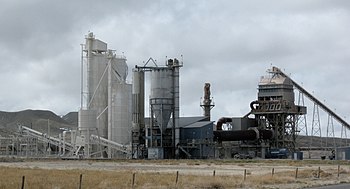
Back Calsinar AN قمين الجير Arabic Forn de calç Catalan Vápenka Czech Kalkofen German Horno de cal Spanish Lubjaahi Estonian Karobi Basque کوره پخت آهک Persian Four à chaux French


A lime kiln is a kiln used for the calcination of limestone (calcium carbonate) to produce the form of lime called quicklime (calcium oxide). The chemical equation for this reaction is
This reaction can take place at anywhere above 840 °C (1,540 °F), but is generally considered to occur at 900 °C (1,650 °F) (at which temperature the partial pressure of CO2 is 1 atmosphere), but a temperature around 1,000 °C (1,830 °F) (at which temperature the partial pressure of CO2 is 3.8 atmospheres[1]) is usually used to make the reaction proceed quickly.[2] Excessive temperature is avoided because it produces unreactive, "dead-burned" lime.
Slaked lime (calcium hydroxide) can be formed by mixing quicklime with water.